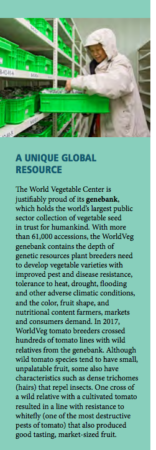- Mr Chetri’s genebank.
- Ruby chocolate. You heard me.
- The next Green Revolution won’t be like the first one. Phew.
- Ideas that will change the world include “super plants” like enset. Right.
- But not, surprisingly, quinoa.
- Or bush tucker.
WorldVeg in strategy reboot
 The World Vegetable Center has a new logo and strategy. Great too see the genebank front and center. More later, after I’ve had a chance to digest it all. Including this paper on their eggplant collection, coincidentally just out.
The World Vegetable Center has a new logo and strategy. Great too see the genebank front and center. More later, after I’ve had a chance to digest it all. Including this paper on their eggplant collection, coincidentally just out.
Oh and I might as well also give a shoutout to SOLCUC2017, the XIV Solanaceae and III Cucurbitaceae Genomics Joint Conference in Valencia, Spain.
The tweeting has already started.
Solanum incanum – the wonder plant!!! #solcuc2017 Pietro Gramazio pic.twitter.com/tgdzYbhM0v
— Sandra Knapp (@SandyKnapp) September 4, 2017
Brainfood: Sustainability index, Beet wild relative, Participatory goats, Sarma, Wild wheat & drought, Ahipa conservation, Saving genebanks, Chinese cattle, Bolivia & CC, Seed systems, Cereal residues
- Sustainability assessment of agricultural systems: The validity of expert opinion and robustness of a multi-criteria analysis. Experts know their stuff.
- Genetic diversity of Patellifolia patellaris from the Iberian Peninsula, a crop wild relative of cultivated beets. 271 individuals, 10 sites, maybe 3 genetic groupings?
- Production system and participatory identification of breeding objective traits for indigenous goat breeds of Uganda. Resistance to biotic and abiotic stresses are the priority.
- Plant diversity for sarma in Turkey: nature, garden and traditional cuisine in the modernity. 73, including 3 endemics.
- Identification of ecogeographical gaps in the Spanish Aegilops collections with potential tolerance to drought and salinity. Evaluation avant la lettre.
- Trends and drivers of on-farm conservation of the root legume ahipa (Pachyrhizus ahipa) in Bolivia over the period 1994/96–2012. Price is too low.
- The Vulnerability of Plant Genetic Resources Conserved Ex Situ. The problem: “…genebanks around the world are generally under stress, largely from inadequate public investment, weakened political support, and insufficient stakeholder engagement.” The solution: privatization, commodification, consolidation, prioritization, communication.
- Species composition and environmental adaptation of indigenous Chinese cattle. Taurine-indicine cline N-S, with traces of banteng, gayal and yak.
- Climate change and crop diversity: farmers’ perceptions and adaptation on the Bolivian Altiplano. Maintaining multiple varieties still done, despite not seen as climate adaptation.
- A Risk Assessment Framework for Seed Degeneration: Informing an Integrated Seed Health Strategy for Vegetatively Propagated Crops. Actually not seed, but rather what to do about pathogen build-up in vegetative planting material. Turns out farmers can be quite good at producing clean material if they can choose healthy plants.
- New criteria for the molecular identification of cereal grains associated with archaeological artefacts. Alkylresorcinols, basically.
Nibbles: Seed saving, Craft saving, Talking sweet potatoes, Breeding eggplants, Cat domestication, Cary on Svalbard, US apple book, US strawberries, Forages newsletter, Banana double
- 94% is the new 75%. Here’s some of the survivors.
- But how many crafts have we lost?
- Win a prize for communicating about sweet potatoes.
- Pre-breeding eggplants using their wild relatives.
- Two waves of cat domestication.
- Svalbard double.
- 350 buck’s worth of apple history.
- 10 cent’s worth of strawberry history.
- Latest newsletter from those nice forages genetic resources conservation folks.
- Bananas good and bad news.
Brainfood: Soybean wild relatives, Durum diversity double, Intensifying livestock, Organic soil, Fodder millet, Brachiaria phylogeny, Use bottlenecks, Another spud, Sclerotinia stem rot, Canola resynthesized
- Characterizing the allopolyploid species among the wild relatives of soybean: Utility of reduced representation genotyping methodologies. Allopolyploids are more than the sum of their diploid progenitors, but also less.
- Genetic Diversity within a Global Panel of Durum Wheat (Triticum durum) Landraces and Modern Germplasm Reveals the History of Alleles Exchange. Modern varieties have a lot of rare alleles, and Ethiopian landraces may be the results of a separate domestication. But I’m not sure you can call this a core collection. Incidentally, genotyped by 35K Affymetrix Axiom wheat breeders array1 at TraitGenetics (Gatersleben, Germany).
- Genome Wide Association Study to Identify the Genetic Base of Smallholder Farmer Preferences of Durum Wheat Traits. Farmers know what they’re talking about. No word on any overlap with above. Incidentally, genotyped on the Infinium 90K wheat chip at TraitGenetics (Gatersleben, Germany). There’s a coincidence!
- The role of livestock intensification and landscape structure in maintaining tropical biodiversity. If we want to keep more livestock while maintaining biodiversity, we should spare forests and avoid using agrochemical inputs. Assuming that dung beetles can stand in for tropical biodiversity as a whole.
- Organic farming enhances soil microbial abundance and activity — A meta-analysis and meta-regression. Especially legumes in crop rotations and organic inputs.
- Identification of promising sources for fodder traits in the world collection of pearl millet at the ICRISAT genebank. From over 300 to about a dozen.
- Genetic Diversity and Population Structure of Brachiaria Species and Breeding Populations. Fancy molecular markers agree with morphology.
- Bottlenecks in the PGRFA use system: stakeholders’ perspectives. Need better policies, capacity and access.
- Solanum jamesii: Evidence for Cultivation of Wild Potato Tubers by Ancestral Puebloan Groups. But does it make good chips?
- Resistance to Sclerotinia sclerotiorum in wild Brassica species and the importance of Sclerotinia subarctica as a Brassica pathogen. Thanks to the U. of Warwick genebank.
- Genetic changes in a novel breeding population of Brassica napus synthesized from hundreds of crosses between B. rapa and B. carinata. Any of them resistant to Sclerotinia?